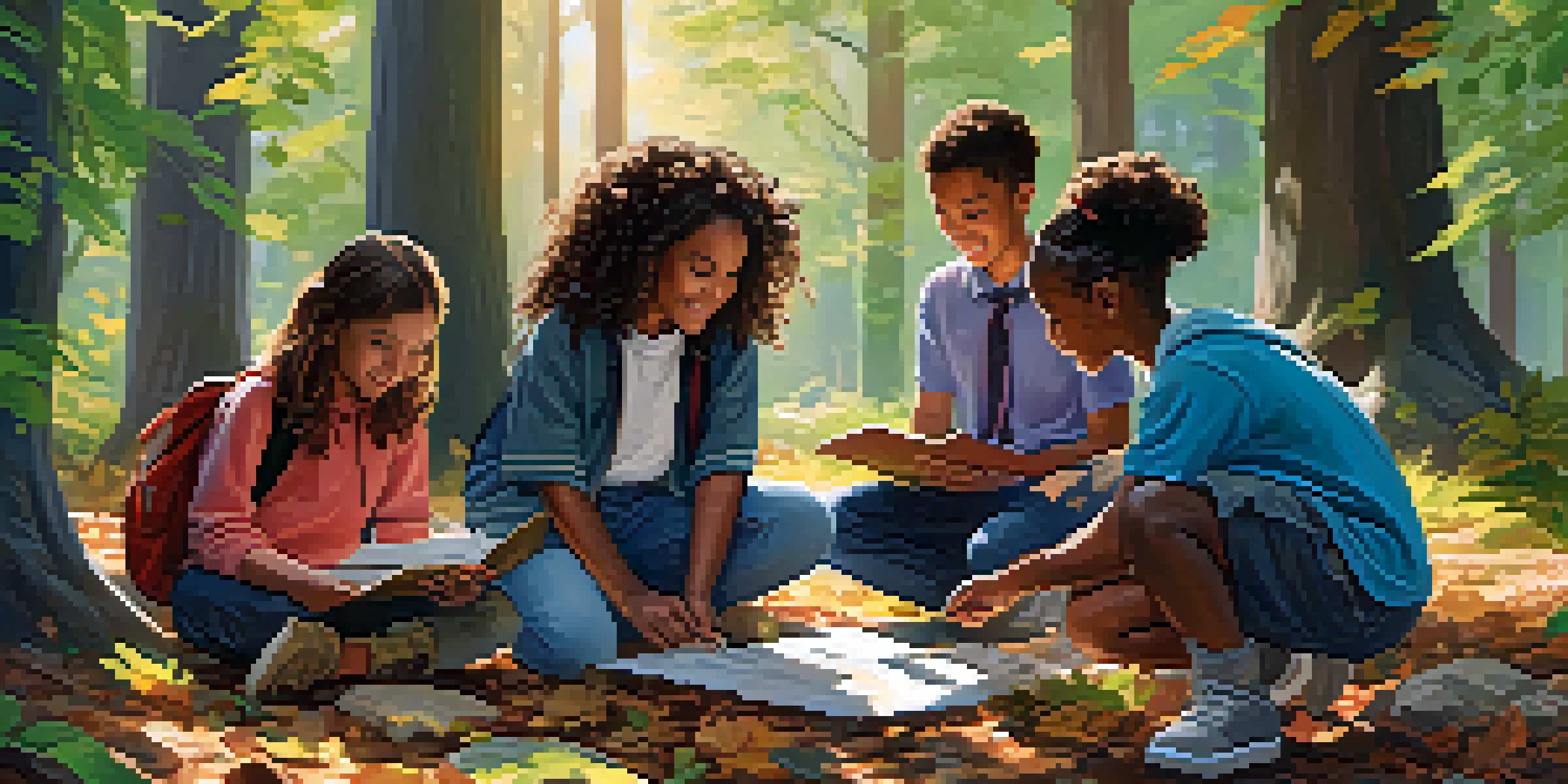Outdoor Learning and the Development of Critical Thinking

Understanding Outdoor Learning and Its Importance
Outdoor learning refers to educational experiences that take place outside the traditional classroom. This approach not only engages students but also encourages them to connect with nature, fostering a deeper understanding of the world around them. By stepping outside, learners can experience lessons in a tangible way, making concepts more relatable and memorable.
The best way to predict the future is to create it.
The importance of outdoor learning lies in its ability to enhance various skills, particularly critical thinking. When students are challenged to solve problems in real-world environments, they develop the ability to analyze, evaluate, and create solutions. This hands-on experience cultivates a sense of curiosity and encourages learners to ask questions and seek answers independently.
Moreover, outdoor learning promotes collaboration among peers, allowing students to exchange ideas and perspectives. This collaborative effort not only strengthens their communication skills but also encourages them to consider multiple viewpoints when tackling challenges, ultimately enhancing their critical thinking abilities.
The Connection Between Nature and Critical Thinking
Nature serves as an incredible backdrop for fostering critical thinking skills. When students are immersed in natural settings, they are often more relaxed and open to exploration. This environment encourages them to observe, question, and engage with their surroundings, which are key components of critical thinking.

For instance, a simple activity like identifying different plant species can lead to discussions about ecosystems, biodiversity, and environmental responsibility. As students become more curious about their findings, they naturally develop analytical skills to synthesize information and draw conclusions. This process of inquiry is fundamental to critical thinking.
Outdoor Learning Boosts Critical Thinking
Engaging students in outdoor experiences enhances their problem-solving and analytical skills through real-world challenges.
Additionally, outdoor learning allows students to confront challenges that require problem-solving. Whether it’s navigating a trail or building a shelter, these activities compel learners to think critically about their choices and the consequences of those choices, reinforcing their ability to make informed decisions.
Hands-On Activities That Promote Critical Thinking
Engaging students in hands-on activities is a cornerstone of outdoor learning. Activities such as scavenger hunts, nature walks, or team-building exercises encourage students to actively participate and apply their critical thinking skills in real-time. These experiences allow them to hypothesize, test their ideas, and reflect on their outcomes.
Education is not the filling of a pail, but the lighting of a fire.
Consider a nature scavenger hunt where students must find specific items or answer questions about their environment. This task not only fosters observation skills but also encourages students to think critically about the relationships between different elements of nature. They learn to analyze their surroundings and make connections that deepen their understanding.
Moreover, incorporating reflective discussions after these activities can enhance critical thinking. By discussing what worked, what didn’t, and why, students can evaluate their thought processes and develop a more robust understanding of the importance of critical analysis in decision-making.
Developing Problem-Solving Skills Through Exploration
Exploration is a fundamental aspect of outdoor learning that naturally enhances problem-solving skills. When students engage in exploratory activities such as hiking or field studies, they often encounter unexpected challenges that require quick thinking and adaptability. This unpredictability is where critical thinking thrives.
For example, if a group encounters a blocked path during a hike, they must assess the situation and decide how to proceed. This scenario encourages them to analyze options, weigh pros and cons, and work collaboratively to find a solution. Such experiences teach students that problem-solving often involves creativity and teamwork.
Nature Encourages Exploration and Inquiry
Immersing students in natural settings fosters curiosity and allows them to engage with their surroundings, promoting critical thinking.
Furthermore, these exploratory activities provide opportunities for students to reflect on their decisions and outcomes. By evaluating their thought processes and the effectiveness of their chosen solutions, learners strengthen their critical thinking skills and become more adept at tackling future challenges.
The Role of Reflection in Outdoor Learning
Reflection is a vital component of outdoor learning, serving as a bridge between experience and understanding. After engaging in outdoor activities, students should take time to reflect on their experiences, discussing what they learned and how they approached various challenges. This practice encourages deeper thinking and insight.
For instance, following a group project in nature, students can share their individual roles and the decisions they made. This not only reinforces their learning but also fosters a sense of accountability and ownership of their thought processes. Reflection helps students internalize their experiences, making the lessons learned more impactful.
Additionally, reflective practices can lead to improved self-awareness. As students critically evaluate their strengths and areas for growth, they become more equipped to apply these insights to future situations, enhancing their overall critical thinking capabilities.
Challenges and Solutions in Outdoor Learning
While outdoor learning offers numerous benefits, it also comes with its own set of challenges. Factors such as weather conditions, safety concerns, and resource availability can pose obstacles to effective outdoor education. However, with careful planning and creativity, these challenges can be addressed.
For example, educators can prepare alternative indoor activities that mimic outdoor experiences, ensuring that critical thinking development continues even when the weather doesn’t cooperate. Additionally, establishing clear safety protocols can alleviate concerns for both educators and students, allowing for a more focused learning experience.
Reflection Enhances Learning Outcomes
Taking time to reflect on outdoor activities helps students internalize their experiences, leading to deeper understanding and improved self-awareness.
Moreover, fostering partnerships with local organizations or community groups can provide additional resources and support for outdoor learning initiatives. By collaborating with experts, educators can enhance the learning experience while ensuring that students benefit from diverse perspectives and knowledge.
Conclusion: Embracing Outdoor Learning for Future Generations
Embracing outdoor learning is essential for fostering critical thinking skills in future generations. As we navigate an increasingly complex world, the ability to think critically and solve problems will be invaluable for students. By providing them with opportunities to learn outside the classroom, we equip them with essential life skills.
Encouraging outdoor learning not only enhances critical thinking but also nurtures a love for nature and the environment. This connection is crucial in promoting responsible citizenship and environmental stewardship among students, helping them to become informed and engaged members of society.

Ultimately, by integrating outdoor learning into educational practices, we can inspire students to become lifelong learners who are curious, adaptable, and capable of navigating the challenges of tomorrow.